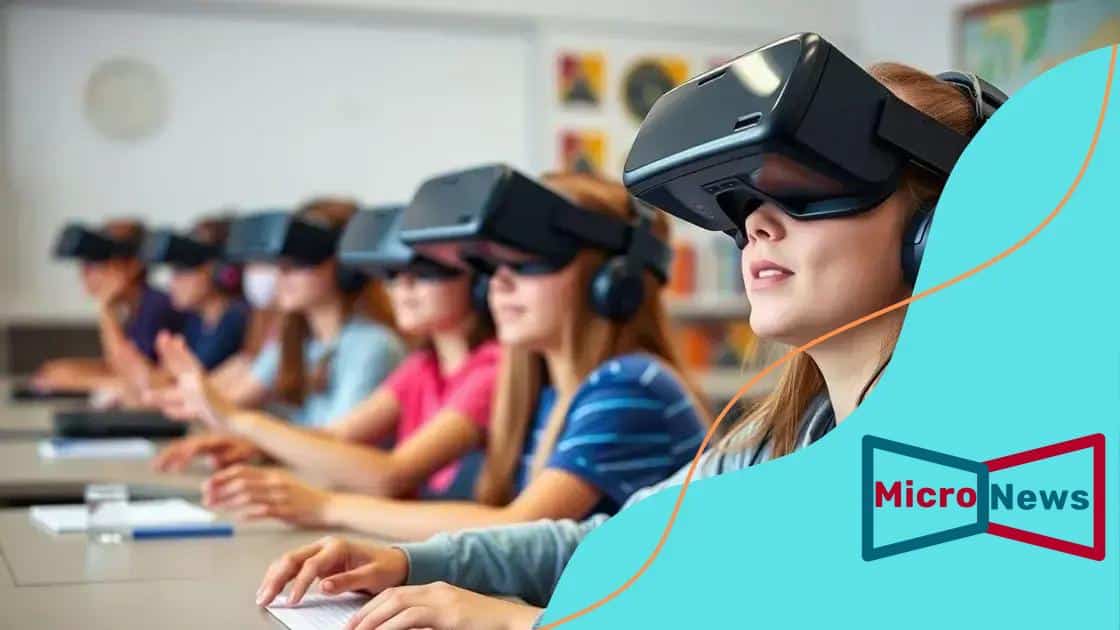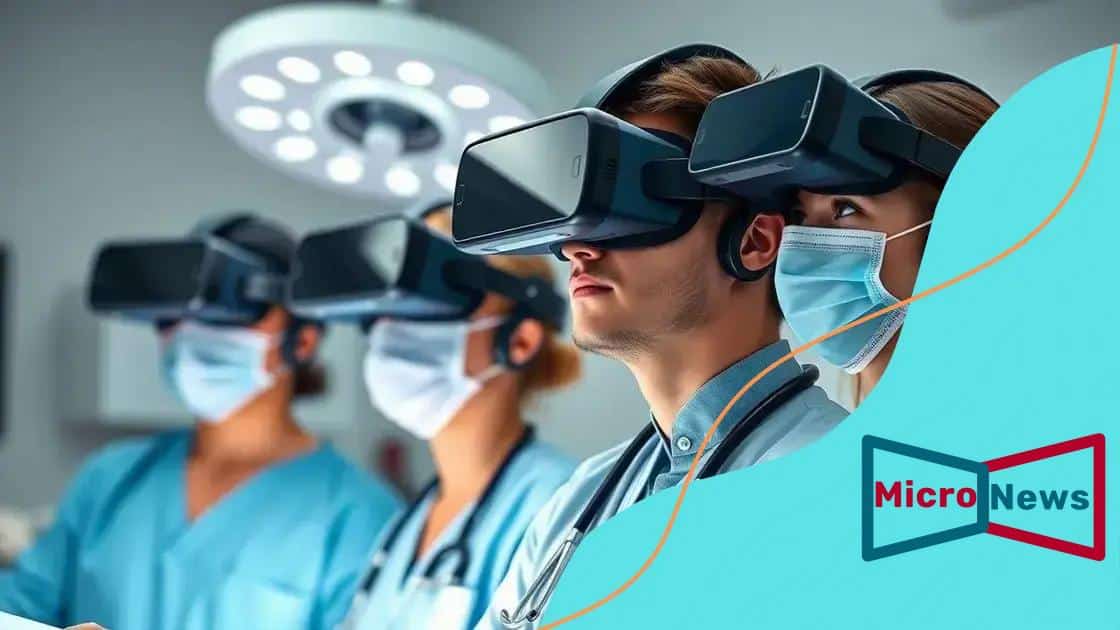Virtual reality in STEM and medical education: transforming learning

Virtual reality in STEM and medical education enhances learning by providing immersive experiences, improving engagement, allowing for practical skills development, and simulating real-world scenarios while addressing challenges like high costs and the need for effective teacher training.
Virtual reality in STEM and medical education is reshaping how students learn. Imagine stepping into a digital world where concepts come to life and hands-on experience is just a headset away. Let’s dive into how this technology is breaking barriers in traditional education methods.
Understanding virtual reality in education
Understanding virtual reality in education is essential for grasping its transformative power. This technology offers immersive experiences that are reshaping how students learn complex subjects.
In particular, when we explore virtual reality in education, it becomes clear that it is not just a novelty but a significant tool. It engages students by providing interactive environments.
How Virtual Reality Works in Education
Virtual reality uses headsets to create 3D simulations. These simulations help students visualize and interact with content like never before.
Benefits of Virtual Reality in Learning
- Enhances engagement through immersive experiences.
- Facilitates better understanding of complex concepts.
- Allows for practical learning without real-world risks.
- Promotes collaborative learning experiences.
These benefits contribute greatly to student motivation. For instance, science classes become lively, as students can conduct virtual experiments without the constraints of a physical lab.
Virtual reality also breaks geographical barriers. Students in remote areas can access lessons and experiences that would otherwise be unavailable. This democratizes education and ensures everyone has the same learning opportunities.
As we look to the future, the potential of virtual reality in education continues to expand. With advancements in technology, we can expect to see more innovative applications in various subjects.
Benefits of VR for STEM learning
The benefits of VR for STEM learning are vast and impactful. By integrating virtual reality into educational settings, educators can enhance student engagement and comprehension in science, technology, engineering, and math disciplines.
One major benefit is the ability to visualize complex concepts. For instance, students can explore the human body in 3D or manipulate molecules to understand chemistry better. This hands-on approach allows learners to grasp ideas that might be abstract in traditional settings.
Enhanced Engagement
When students use VR, they are not just passive recipients of information; they become active participants. This immersion leads to increased motivation and interest in STEM subjects.
Practical Application
- Students can conduct virtual experiments safely.
- They can simulate engineering projects and understand design processes.
- Real-world problem-solving scenarios are introduced through VR.
- Field trips become accessible, regardless of geographical limitations.
Furthermore, the interactive nature of virtual reality encourages collaboration among peers. When working together in VR, students can share thoughts and build on each other’s ideas; this teamwork is vital for success in STEM fields.
Moreover, VR can cater to diverse learning styles. Visual learners benefit from seeing simulations, while kinesthetic learners thrive in interactive environments.
The incorporation of virtual reality in STEM education not only prepares students for future careers but also equips them with critical thinking and problem-solving skills necessary for navigating a complex world.
Applications of VR in medical training

The applications of VR in medical training are revolutionizing how future healthcare professionals learn. With the help of virtual reality, medical students can practice their skills in realistic scenarios without the risks associated with traditional training.
One key advantage of using VR is the ability to simulate complex medical procedures. Students can perform surgeries in a controlled environment. This simulation helps them develop confidence and improve their technique before working with real patients.
Realistic Scenario Training
VR provides lifelike scenarios that mimic actual medical situations. This immersive experience allows students to practice decision-making and critical thinking under pressure.
Benefits of VR in Medical Education
- Safe practice of surgical techniques and procedures.
- Immediate feedback on performance to improve skills.
- Accessibility to rare medical cases for comprehensive training.
- Reduction of training costs and resource needs.
Moreover, the use of VR in medical training helps students understand anatomy better. They can visualize the human body in 3D, making it easier to learn complex structures. This three-dimensional view enhances comprehension compared to traditional textbooks.
Another significant aspect is the training of soft skills. VR can simulate patient interactions, allowing students to practice communication and empathy skills in a safe setting. This training is crucial for providing holistic care to patients.
As technology continues to advance, the applications of virtual reality in medical training will likely expand. This expansion ensures that healthcare professionals are well-prepared for the challenges they will face in their careers.
Challenges in implementing VR in education
The challenges in implementing VR in education are varied and significant. While virtual reality offers many benefits, incorporating it into educational systems does present hurdles that need to be addressed.
One primary concern is the cost of VR technology. Schools often face budget limitations, making it difficult to purchase the necessary headsets and software. Additionally, maintaining and updating the technology can strain financial resources.
Technical Issues
Technical problems can hinder VR implementation. If the hardware malfunctions or software updates are needed, classrooms might experience disruptions. These interruptions can disrupt learning and frustrate both teachers and students.
Teacher Training
- Teachers may need specific training to use VR effectively.
- Without proper understanding of the technology, lessons may not be executed well.
- Ongoing support is essential for successful integration.
- Lack of confidence in using VR can limit its effectiveness.
Another challenge lies in developing appropriate content. While some quality VR educational programs exist, many subjects still lack adequate resources. Teachers may struggle to find engaging VR materials that align with their curriculum.
Furthermore, there are concerns regarding accessibility. Not all students have equal access to VR technology, which can create disparities in learning experiences. Schools in underfunded areas might lag in adopting these innovative tools.
Despite these challenges, ongoing advancements in virtual reality and increased awareness among educators could lead to solutions. It is essential to tackle these issues to maximize the potential of VR in enhancing education.
Future trends in VR for education
The future trends in VR for education show promising advancements that can further transform learning. As technology evolves, virtual reality will play an even more significant role in classrooms.
One exciting trend is the integration of artificial intelligence with VR. This combination can create personalized learning experiences, adapting content to meet individual student needs. Imagine a classroom where every student learns at their own pace using an AI that responds to their specific challenges.
Collaborative Learning Environments
Another trend includes creating more collaborative learning experiences. Students from different locations can join virtual classrooms, working together on projects in real time. This collaboration promotes teamwork and encourages diverse perspectives.
Improved Accessibility
- Increased availability of affordable VR devices.
- Better internet access in remote areas.
- Development of inclusive content for all learning styles.
- Greater support for diverse student populations.
As VR technology continues to improve, we can expect to see enhanced graphics and more realistic simulations. These advancements will make immersive learning experiences even more engaging. Students will not just learn about science; they can conduct virtual experiments and see real-time results.
Moreover, educational institutions will likely incorporate VR training for teachers. This training will empower educators to effectively use VR tools within their curriculum. Schools that embrace these trends will better prepare students for future careers in a rapidly changing world.
With the potential for limitless applications, virtual reality is set to redefine education, making it more engaging, accessible, and effective for learners everywhere.
In summary, the integration of virtual reality into education is changing the way students learn. With its many benefits, such as improved engagement and practical applications, VR offers a new path for educational experiences. While challenges remain in implementation, the potential of this technology is immense. As we look ahead, embracing future trends in VR will ensure that education remains relevant, accessible, and engaging for all students.
FAQ – Frequently Asked Questions about Virtual Reality in Education
What are the main benefits of using VR in education?
The main benefits include enhanced engagement, practical skill development, and the ability to simulate real-world experiences in a safe environment.
How can VR improve STEM learning specifically?
VR allows students to visualize complex concepts in 3D, conduct virtual experiments, and collaborate with peers, which enhances overall understanding and retention.
What challenges do schools face when implementing VR?
Challenges include high costs, the need for teacher training, and technical issues that can disrupt learning experiences.
What future trends can we expect in VR education?
Future trends include integrating AI for personalized learning experiences, promoting collaborative environments, and improving accessibility to VR technologies.





